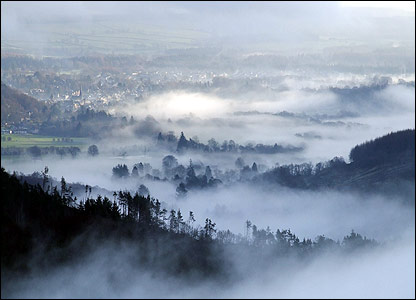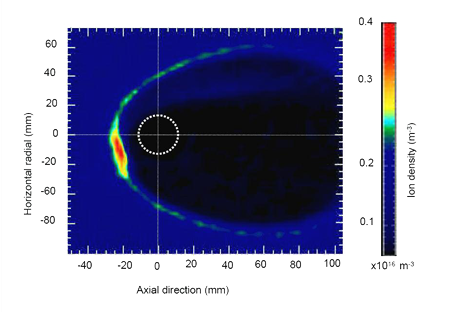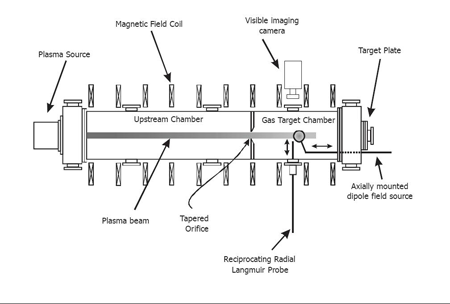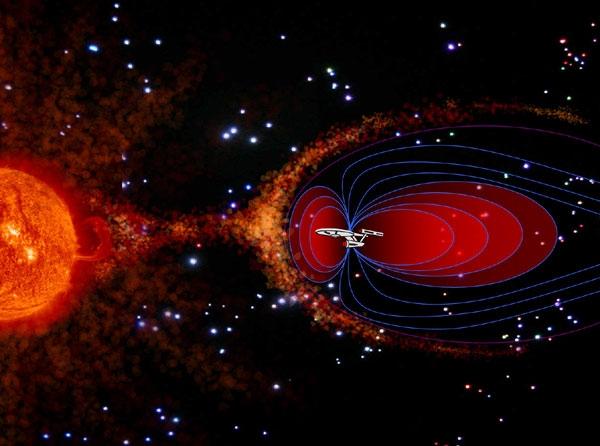Science news
4-Nov-2008 00:00 Eastern US Time

Force- field for Mars craft
Scotland and space have several things in common. Both have too much weather for a start.
But how can that be? Weather in Scotland, and everywhere else on Earth, is about how the air around us moves and changes. There is no air in space. So where does space weather come from?
Mostly from the Sun. And it's dangerous stuff. The solar wind is a stream of charged particles that are moving so fast they cause serious damage to materials and equipment - and to humans. There is also some danger to space travellers of being zapped by particles from further away, known as cosmic rays.
But new research is showing how the threat from all this radiation can be reduced - and the first human mission to Mars made much safer. The research is published today in IOP Publishing's Plasma Physics and Controlled Fusion. This new research builds on knowledge gained from 50 years of nuclear fusion science and engineering.
Stormy weather

Space weather, like Earth weather, is pretty unpredictable. On a lovely day a severe change in the weather might already be on its way. The sun sends out streams of charged particles without much warning. When they reach Earth's atmosphere they cause the streamers of lights in the sky known as the aurora borealis and aurora australis - the northern and southern lights. They damage satellites. They can cause electrical blackouts.
If they reached the surface in large numbers they would make most life on Earth, including human life, impossible.
But Earth has a natural force field that protects us all. It is the same magnetic field we use to find our way among the mountains, jungles and deserts using a compass. This magnetic field changes the flight of the high-energy particles, bending them around the Earth and off into space again. It is a bit like being inside a giant bubble.
Out in the rain
The Apollo astronauts of the 1960's and 70's who walked on the Moon are the only humans to have travelled beyond this magnetic bubble - which scientists call the magnetosphere. But typical Apollo journeys only lasted about eight days. So it was possible to miss meeting a solar storm. And they all did - although at times it was a close call.
A journey to Mars would take about a year and a half. In all that time it is almost certain that the astronauts would be hit by a solar storm. Engineers have got used to building equipment into unmanned spacecraft that doesn't fail as soon as high energy particles hit. These methods won't work for humans. So the first people to travel to Mars could easily get so much radiation on the way that they become very ill or die.
So what's the answer?
Tiny bubbles
Well, why not give spacecraft their own magnetic bubbles? It's an idea that has been around for a while - since at least the 1960's. But until now scientists and engineers thought it couldn't be made to work because a spacecraft would need a very large power supply to create a strong enough magnetic bubble - and the bubble would be enormous, maybe 100 kilometres across.

The new research shows this was wrong - spacecraft can be given magnetic bubbles small enough to make the whole idea workable.
The researchers who carried out the latest work are based at the Science and Technology Facilities Council's Rutherford Appleton Laboratory, the University of Strathclyde, the University of York and IST Lisbon. They have been taking several different approaches to the research.
Fusion connection
Computer simulation is one of these. Last year, teams of researchers in Lisbon and at Rutherford Appleton carried out simulations that showed that a much smaller magnetic bubble - just a few hundred metres across - should be enough to protect a spacecraft.
Now UK scientists have taken this an important step further. They have created a small solar wind in the laboratory and studied what happens when little magnets are placed in its path.
The connection with nuclear fusion is that fusion needs very high temperatures. At these temperatures the hydrogen fuel is not a normal gas but a plasma. So fusion scientists and engineers are experts in how plasma behaves and how to alter that behaviour using magnetic fields.
This is exactly what is needed with the solar wind and a magnetic bubble around a space-ship. So the scientists have been using equipment and methods first developed for fusion research.

In the lab
They have been firing high temperature hydrogen plasma down a steel tube 1.5 metres long, out of which all air has been pumped. Inside the tube they put a small magnet at several different places and watched and measured how the plasma flowed around it.
They also used a computer program to try to predict what would happen and compared the results of that with the experimental results.
Both these approaches gave the same answer - the high-energy plasma can be kept out of a small magnetic bubble.
What's next?
This is not the end of the line for this research, by any means. Future work will study how the size of the bubble changes with the strength of the magnetic field. It will look in detail at what is going on at the edge of the bubble and whether it ever collapses. It will improve the models and the experiments.
But the results so far are very promising, say the scientists - not to mention reassuring for anyone who dreams of being part of the first mission to Mars. "These initial experiments have shown promise," says Ruth Bamford of the Rutherford Appleton Laboratory. "It may well be possible to shield astronauts from deadly space weather".
This story is adapted from a press release written by Joe Winters, press officer at the Institute of Physics.
"The Interactions of a flowing plasma with a dipole magnetic field: measurements and modelling of a diamagnetic cavity relevant to spacecraft protection" (R Bamford et al 2008 Plasma Phys. Control. Fusion 50 124025).
Plasma Physics and Controlled Fusion covers all aspects of the physics of hot, highly ionised plasmas.
More help with words
| attract | device | electric charge | electron | element |
| energy | experiment | fundamental | ion | mathematical model |
| matter | nuclei | nucleus | orbit | particle |
| planet | proton | neutron | repel | solar system |
What's it all about?
- What do space and Scotland have in common?
- Weather is about how air - - - - - and - - - - - - -
- So why is weather in space a strange idea?
- Where does space weather mostly come from?
- Why is it dangerous?
- This new research is about how to protect space travellers from space weather? Where will they be travelling to?
- What is space weather made of?
- State two things that space weather from the sun can do when it reaches Earth.
- What would happen to life on Earth if all this stuff from the sun reached the surface?
- What is it that stops this happening?
- How does it do that?
- Why will space travelers to Mars be much more likely to meet a storm from the sun than the Apollo astronauts?
- What was thought to be the problem with magnetic bubbles for spaceships?
- What is the main conclusion of this new research?
- Was this result totally unexpected? Explain your answer.
- In one sentence and your own words state what the scientists have done.
- What is the connection with nuclear fusion?
- In what way is a plasma different from a gas?
- Describe briefly the equipment the scientists have been using.
- What would they like to do next and why?


